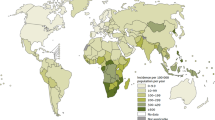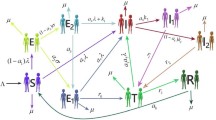Abstract
Diabetes is chronic, noncommunicable disease, affecting a large population, specially in asian countries like India and China. Tuberculosis is also a major threat to health worldwide. It has been reported that diabetes increases the risk of tuberculosis infection threefold and thus creating a joint epidemic. Therefore, in this article, we study the association of diabetes with tuberculosis infection through a Mathematical modeling approach. We have taken published data of diabetic people having tuberculosis infections from six DM clinics of Indian territory hospitals. For parameters, we have taken previously standarized published values. We have expressed the model with the help of differential equations. Further, we study the stability of the critical points for diabetes with tuberculosis infection. Finally, we perform some numerical experiments using fourth order Adams–Bashforth–Moulton predictor corrector method to improve some existing results. This study highlights that tuberculosis infections among diabetic people are higher. It also shows the pattern of tuberculosis infection among diabetic people. By finding stable point of these diseases outbreak, it gives us the insight about the preventive measures to control this joint epidemic in a better way.





Similar content being viewed by others
References
Ajmera, I., M. Swat, C. Laibe, N.L. Novre, and V. Chelliah. 2013. The Impact of Mathematical Modeling on the Understanding of Diabetes and Related Complications. CPT: Pharmacometrics & Systems Pharmacology 2 (7): 1–14.
Boutayeb, A., A. Chetouani, K. Achouyab, and E. Twizell. 2006. A non-linear population model of diabetes mellitus. Journal of Applied Mathematics and Computing 21 (1–2): 127–139.
Boutayeb, A., E. Twizell, K. Achouyab, and A. Chetouani. 2004. A mathematical Model for the Burden of Diabetes and Its Complications. BioMedical Engineering 3: 1–8.
Chaudhary, S., A. Thukral, S. Tiwari, D.D. Pratyush, and S.K. Singh. 2013. Vitamin D status of patientswithtype 2 diabetes and sputum positive pulmonary tuberculosis. Indian Journal of Endocrinology and Metabolism 17 (3): 670–673.
Dooley, K.E., T. Tang, J.E. Golub, S.E. Dorman, and W. Cronin. 2009. Impact of diabetes mellitus on treatment outcomes of patients with active tuberculosis. American Journal of Tropical Medicine and Hygiene 80 (4): 634–639.
Harries, A.D., et al. 2013. Epidemiology and Interaction of Diabetes Mellitus and Tuberculosis and Challenges for Care: A Review. Public Health Action 3 (1): 3–9.
Kumar, A., et al. 2013. Screening of patients with diabetes mellitus for tuberculosis in India. Tropical Medicine & International Health 18 (5): 636–645.
Leung, Chi, et al. 2008. Diabetic control and risk of tuberculosis: a cohort study. American Journal of Epidemiology 167 (12): 1486–1494.
Lnnroth, K., G. Roglic, and A.D. Harries. 2014. Improving tuberculosis prevention and care through addressing the global diabetes epidemic: from evidence to policy and practice. The Lancet Diabetes & Endocrinology 2 (9): 730–739.
Muruganathan A., and V. Viswanathan. 2016. The double burden of tuberculosis and diabetes in India. In Diabetology. Complications of diabetes, ed. M. Wishwanathan, 23–30. New Delhi: Jaypee publication.
Niemi, M., J. Backman, M. Neuvonen, P. Neuvonen, and K.T. Kivist. 2001. Effects of rifampin on the pharmacokinetics and pharmacodynamics of glyburide and glipizide. Clinical Pharmacology & Therapeutics 69 (6): 400–406.
Qu, H.-Q., et al. 2012. Host Susceptibility to Tuberculosis: Insights from a Longitudinal Study of Gene Expression in Diabetes. International Journal of Tuberculosis and Lung Disease 16 (3): 370–372.
Ramachandran, A., R.C.W. Ma, and S. Chamukuttan. 2010. Diabetes in Asia. The Lancet 375 (9712): 408–418.
Ruslami, R., R.E. Aarnoutse, B. Alisjahbana, A.J.A.M.V.D. Ven, and R.V. Crevel. 2010. Implications of the global increase of diabetes for tuberculosis control and patient care. Tropical Medicine & International Health 15 (11): 1289–1299.
Shetty, N., M. Shemko, M. Vaz, and G.D. Souza. 2006. An epidemiological evaluation of risk factors for tuberculosis in South India: a matched case control study. The International Journal of Tuberculosis and Lung Disease 10 (1): 80–86.
Stevenson, C.R., et al. 2007. Diabetes and tuberculosis: theimpact of the diabetes epidemicon tuberculosis incidence. BMC Public Health 7: 1–8.
Wang, Q., et al. 2013. Rationale and design of a randomized controlled trial of the effect of retinol and vitamin D supplementation on treatment in active pulmonary tuberculosis patients with diabetes. BMC Infectious Diseases 13: 1–7.
Whiting, D.R., L. Guariguata, C. Weil, and J. Shaw. 2011. IDF diabetes atlas: global estimates of the prevalence of diabetes for 2011 and 2030. Diabetes Research and Clinical Practice 94 (3): 311–321.
World Health Organization. 2013. Global Tuberculosis Report 2013. Geneva: WHO. http://www.who.int/iris/handle/10665/91355. Accessed 2 July 2017.
Zheng, C., M. Hu, and F. Gao. 2017. Diabetes and Pulmonary Tuberculosis: A Global Overview with Special Focus on the Situation in Asian Countries with High TB-DM Burden. Global Health Action 10 (1): 1–11.
Acknowledgements
The authors would like to thank Department of Science and Technology DST-FIST Level-1 Program Grant No. SR/FST/MSI-092/2013 for providing the computational facilities. The third author was partially supported by a Grant from the Department of Science and Technology (DST-SERB), India under Grant No. EMR/2016/002883. The authors thank the anonymous reviewers for their valuable comments and helpful suggestions.
Author information
Authors and Affiliations
Corresponding author
Rights and permissions
About this article
Cite this article
Dhara, M., Baths, V. & Danumjaya, P. Mathematical modeling and dynamics of tuberculosis infection among diabetic patients in India. J Anal 27, 451–463 (2019). https://doi.org/10.1007/s41478-018-0086-5
Received:
Accepted:
Published:
Issue Date:
DOI: https://doi.org/10.1007/s41478-018-0086-5




